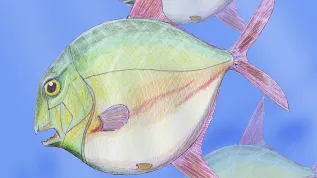
Driving through the forests near Kraków, you can see ropes hanging over the roads. They are crossings that will facilitate dating of dormice - some of the most secretive rodents that live in Poland - told PAP naturalist Wojciech Nowakowski.
Dormice are small rodents, represented in Poland by only few species living mainly in the east and south of the country. Few people know even the most common hazel dormice. Layman will probably think it is a reddish mouse with furry tail. In contrast, it is easy to recognise edible dormouse with its gray-white fur, fluffy tail and big ears. Groups of the species are found in the mountains: Tatras, Bieszczady and Pieniny. It is less common in Kozienice Forest, Białowieża Forest and Sobibór Forest.
"It sounds strange, but even biologists professionally specialising in forest ecology, who are in the field every day, rarely see dormice" - admitted Nowakowski, who has been studying these animals for more than two decades. - They are difficult to observe and secretive. Not only do they lead nocturnal life, they tend to stay high in the trees, live in small densities, and you can see them in the woods only from spring to autumn, because they hibernate the rest of the time".
A much rarer forest dormouse resembles a large hazel dormouse in the mask of Zorro. We will probably never see the fourth dormouse previously found in Poland, garden dormouse - said Nowakowski, who formerly worked at the University of Natural Sciences and Humanities in Siedlce, and now is an environmental protection professional.
This summer, edible and hazel dormice (the only dormice living in the Polish Jura) received special bridges. Over the roads in the Kraków part of the Jura, naturalists hanged jury with installed shelters: plastic boxes and mesh sleeves, allowing rodents to hide from predators, for example owls.
The ropes have a similar function bridges and tunnels built over the roads (or under them) for wild animals: lynx, wild boar, deer, wolves, badgers, hedgehogs, rodents and frogs. The ropes will increase the safety of dormice living in the area.
They will also improve the rodents’ social life.
The ability to cross over the road will give the rodents more freedom in finding partners and allow them to freely exchange genes. "Mixing genes is to be or not to be for a species. It prevents inbreeding - a situation in which the animals breed in a small group, which increases the risk of various diseases. Contrary to popular belief, even parasites feel much better in closed populations, and the opening of the population clearly reduces their pressure" - explained the biologist.
For the genes to mix, a sufficiently large group of individuals must have unobstructed contact. According to Wojciech Nowakowski, it is assumed that safe population size for rodents is approx. 2.5 thousand individuals. Statistically, one dormouse needs approx. 1 ha of forest. Maintaining a healthy population requires a forest with an area of 2.5 thousand ha. There aren’t many such forests in Poland. In general, forests are divided by roads, and once large populations living there are divided into smaller groups and isolated. Crossing a fenced the highway is almost impossible for animals, and crossing a regular road - very risky, as evidenced by the multitude of small forest animals run over by cars.
Special crossings are built to facilitate contact between animals living on both sides of roads. Dormice do not use them, however - even in the woods they are reluctant to come down from the trees to the ground. They do it in only three situations: when fleeing from an owl or marten, searching for raspberry and blueberry, and in mid-October, when they prepare to hibernate and seek shelter.
For dormice, each new road a barrier obstructing their trails in the trees. We know that they try to cross the roads, because run over animals are sometimes found on the asphalt. "They\'re trying to cross, but they do it in desperation, because on the asphalt they can easily fall prey to predators - foxes, raccoons, even cats, and they may end up as road kill" - explained Nowakowski.
"The dormice populations are small, but large enough to be worth fighting for" - believes Nowakowski, who convinced landscape parks in Małopolska to the idea of hanging bridges, having gained support of Marek Kołodziej and Piotr Sułek from the Department of Landscape Parks of the Małopolska Region in Kraków. Installed crossings, hung in three parks, were funded by the Regional Fund for Environmental Protection and Water Management in Kraków.
"We are the first in Europe and second in the world" - emphasized the biologist. The first bridges were hanged in Japan, the home of Japanese dormouse, which lives in small plots of forest cut by highways. Ropes are hanged there in special rigid structures, covered by vines and orchids. The idea was a success, dormice started nesting on the bridges.
Bridges in the Jura were hanged during the summer. It is still unclear whether dormice use them. "We\'ll find out when a photo trap is installed on one of the ropes - said the biologist. -Autumn is coming and dormice stay on familiar paths. Males and females are not looking for each other, they know their areas, they know where the food is. Instead of looking for thrills, dormice look for places to hibernate. They are more likely to start using the ropes in the spring, when after the period of hibernation the animals will be regaining their territories".
PAP - Science and Scholarship in Poland, Anna Ślązak
zan/ agt/ mrt/
tr. RL













